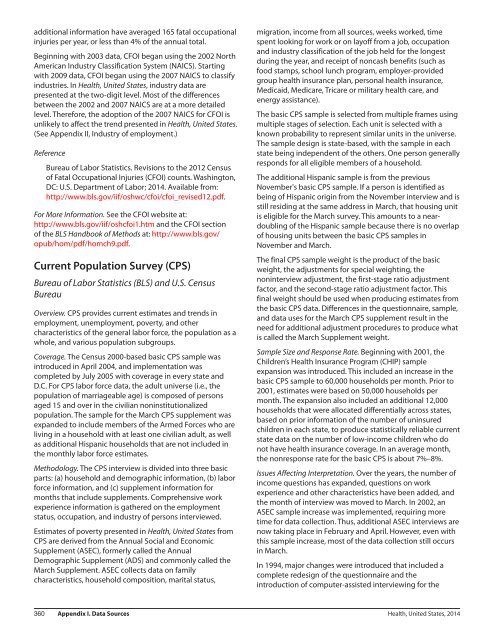hus14
hus14
hus14
You also want an ePaper? Increase the reach of your titles
YUMPU automatically turns print PDFs into web optimized ePapers that Google loves.
additional information have averaged 165 fatal occupational<br />
injuries per year, or less than 4% of the annual total.<br />
Beginning with 2003 data, CFOI began using the 2002 North<br />
American Industry Classification System (NAICS). Starting<br />
with 2009 data, CFOI began using the 2007 NAICS to classify<br />
industries. In Health, United States, industry data are<br />
presented at the two-digit level. Most of the differences<br />
between the 2002 and 2007 NAICS are at a more detailed<br />
level. Therefore, the adoption of the 2007 NAICS for CFOI is<br />
unlikely to affect the trend presented in Health, United States.<br />
(See Appendix II, Industry of employment.)<br />
Reference<br />
Bureau of Labor Statistics. Revisions to the 2012 Census<br />
of Fatal Occupational Injuries (CFOI) counts. Washington,<br />
DC: U.S. Department of Labor; 2014. Available from:<br />
http://www.bls.gov/iif/oshwc/cfoi/cfoi_revised12.pdf.<br />
For More Information. See the CFOI website at:<br />
http://www.bls.gov/iif/oshcfoi1.htm and the CFOI section<br />
of the BLS Handbook of Methods at: http://www.bls.gov/<br />
opub/hom/pdf/homch9.pdf.<br />
Current Population Survey (CPS)<br />
Bureau of Labor Statistics (BLS) and U.S. Census<br />
Bureau<br />
Overview. CPS provides current estimates and trends in<br />
employment, unemployment, poverty, and other<br />
characteristics of the general labor force, the population as a<br />
whole, and various population subgroups.<br />
Coverage. The Census 2000-based basic CPS sample was<br />
introduced in April 2004, and implementation was<br />
completed by July 2005 with coverage in every state and<br />
D.C. For CPS labor force data, the adult universe (i.e., the<br />
population of marriageable age) is composed of persons<br />
aged 15 and over in the civilian noninstitutionalized<br />
population. The sample for the March CPS supplement was<br />
expanded to include members of the Armed Forces who are<br />
living in a household with at least one civilian adult, as well<br />
as additional Hispanic households that are not included in<br />
the monthly labor force estimates.<br />
Methodology. The CPS interview is divided into three basic<br />
parts: (a) household and demographic information, (b) labor<br />
force information, and (c) supplement information for<br />
months that include supplements. Comprehensive work<br />
experience information is gathered on the employment<br />
status, occupation, and industry of persons interviewed.<br />
Estimates of poverty presented in Health, United States from<br />
CPS are derived from the Annual Social and Economic<br />
Supplement (ASEC), formerly called the Annual<br />
Demographic Supplement (ADS) and commonly called the<br />
March Supplement. ASEC collects data on family<br />
characteristics, household composition, marital status,<br />
migration, income from all sources, weeks worked, time<br />
spent looking for work or on layoff from a job, occupation<br />
and industry classification of the job held for the longest<br />
during the year, and receipt of noncash benefits (such as<br />
food stamps, school lunch program, employer-provided<br />
group health insurance plan, personal health insurance,<br />
Medicaid, Medicare, Tricare or military health care, and<br />
energy assistance).<br />
The basic CPS sample is selected from multiple frames using<br />
multiple stages of selection. Each unit is selected with a<br />
known probability to represent similar units in the universe.<br />
The sample design is state-based, with the sample in each<br />
state being independent of the others. One person generally<br />
responds for all eligible members of a household.<br />
The additional Hispanic sample is from the previous<br />
November's basic CPS sample. If a person is identified as<br />
being of Hispanic origin from the November interview and is<br />
still residing at the same address in March, that housing unit<br />
is eligible for the March survey. This amounts to a neardoubling<br />
of the Hispanic sample because there is no overlap<br />
of housing units between the basic CPS samples in<br />
November and March.<br />
The final CPS sample weight is the product of the basic<br />
weight, the adjustments for special weighting, the<br />
noninterview adjustment, the first-stage ratio adjustment<br />
factor, and the second-stage ratio adjustment factor. This<br />
final weight should be used when producing estimates from<br />
the basic CPS data. Differences in the questionnaire, sample,<br />
and data uses for the March CPS supplement result in the<br />
need for additional adjustment procedures to produce what<br />
is called the March Supplement weight.<br />
Sample Size and Response Rate. Beginning with 2001, the<br />
Children’s Health Insurance Program (CHIP) sample<br />
expansion was introduced. This included an increase in the<br />
basic CPS sample to 60,000 households per month. Prior to<br />
2001, estimates were based on 50,000 households per<br />
month. The expansion also included an additional 12,000<br />
households that were allocated differentially across states,<br />
based on prior information of the number of uninsured<br />
children in each state, to produce statistically reliable current<br />
state data on the number of low-income children who do<br />
not have health insurance coverage. In an average month,<br />
the nonresponse rate for the basic CPS is about 7%–8%.<br />
Issues Affecting Interpretation. Over the years, the number of<br />
income questions has expanded, questions on work<br />
experience and other characteristics have been added, and<br />
the month of interview was moved to March. In 2002, an<br />
ASEC sample increase was implemented, requiring more<br />
time for data collection. Thus, additional ASEC interviews are<br />
now taking place in February and April. However, even with<br />
this sample increase, most of the data collection still occurs<br />
in March.<br />
In 1994, major changes were introduced that included a<br />
complete redesign of the questionnaire and the<br />
introduction of computer-assisted interviewing for the<br />
360 Appendix I. Data Sources Health, United States, 2014


